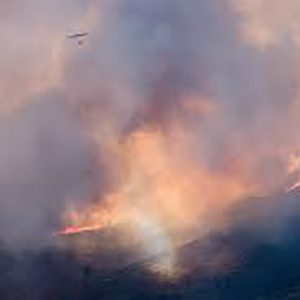
Prepping for Poor Air Quality
Written by,
Dr. Bob Lutz, Health Officer, Spokane Regional Health District
With Spokane’s history in recent summers of poor air quality due to regional wildfires, it is no longer an issue of “if” air quality will be a concern in the summer, but “when.” Spokane Regional Health District is grateful to its partners like Spokane Regional Clean Air Agency, Washington State Department of Health, Washington State Department of Labor & Industries (L&I), weather and fire officials, and so many more who join us in urging residents, when air quality is unhealthy, to take specific precautions to protect their health, like staying indoors. This year, however, we want our community to get ahead of the curve in preparing. There are several things people can be doing now to protect themselves and others before the smoke rolls in.
First, it helps to understand what wildfire smoke is and why it can be harmful. It is a mix of gases and fine particles that can make anyone sick. Breathing in smoke can have immediate health effects, including coughing, shortness of breath, chest pain, stinging eyes, increased heart rate, headaches and tiredness. Certain populations are at risk for acute respiratory problems from wildfire smoke, such as those with asthma and chronic bronchitis. These individuals should have a plan in place with their medical provider to manage their respiratory and/or heart health. Children are also at increased risk due to their developing respiratory systems and breathing rates, especially when playing.
Based on air quality and health status, choose your summer activities wisely. Pay attention to local air quality reports. Spokane Regional Clean Air Agency offers a current, regional air quality index at spokanecleanair.org/current-air-quality. While you’re there, sign up for air quality alerts via email or text. The values are updated hourly and put more weight on the most recent air pollution reading.
When air quality enters the ‘Moderate’, or yellow range, if you have asthma, diabetes, lung or heart disease; have had a stroke; or are currently experiencing a respiratory infection, consider limiting your outdoor activities or choose those of lesser effort. This should definitely be your plan if we move into the orange range, or ‘Unhealthy for Sensitive Groups’.
For healthy individuals, the ‘Unhealthy’, or red range, is your signal to limit outdoor activities. In these conditions, everyone should avoid exercising outdoors and at-risk groups should stay indoors. Once we enter the purple and maroon ranges, everyone should stay indoors. You should close your windows and, if available, run the air conditioner on re-circulate. Wait until air quality is better before you go back outside.
For people who have to work outside, drink lots of water and check with your employer about taking more frequent breaks. According to L&I, employers are not required to provide masks and for good reason. As far as masks are concerned, paper "comfort" or "dust" masks are not the answer, and this applies to all individuals, not just outdoor workers. These masks are only designed to trap large particles, such as sawdust, meaning they do not protect lungs from the fine particles in smoke. Respirator masks labeled N95 or N100 provide some protection, if, and I do emphasize if, they are fitted properly—a challenge when it comes to facial hair. These masks filter out some fine particles, but not the hazardous gases in smoke such as carbon monoxide, formaldehyde, and acrolein. Respirator masks are also not intended for kids or long-term exposure. Our guidance is always to reduce exposure by staying indoors. More tips for a safe wildfire season can be found on our site at srhd.org
Dr. Bob Lutz
Dr. Lutz is a board-certified family medicine physician who is currently the health officer for Spokane County.
